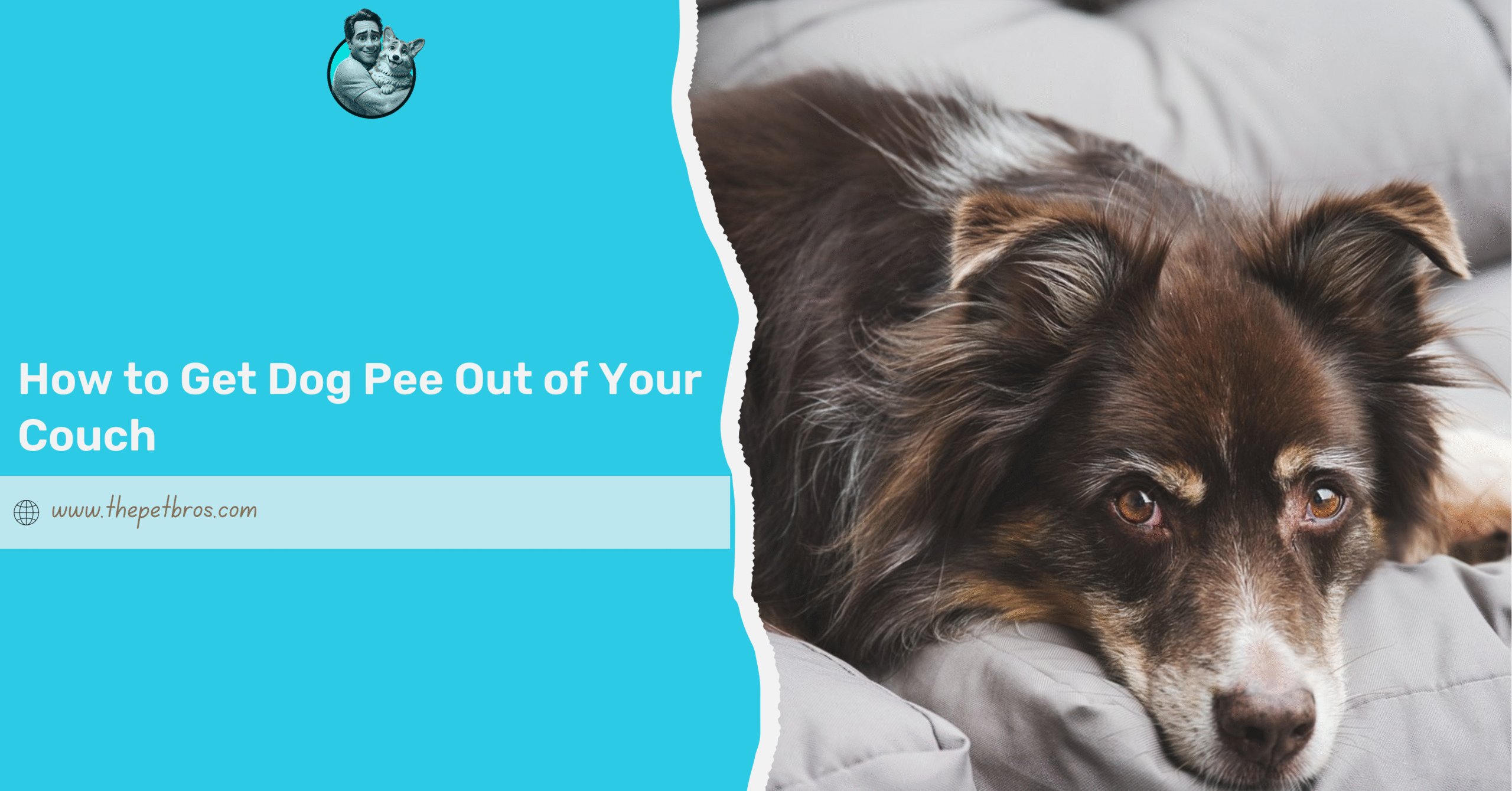We’ve all been there: you’re relaxing on your couch, enjoying a quiet moment, when you suddenly notice an unpleasant surprise. Your dog has had an accident. He peed on your precious couch. Honestly, how to get dog pee out of your couch is a question no pet owner wants to ask, but it’s one we’ve all faced at some point. Dog pee on the couch is never fun, whether it’s from a puppy still learning the ropes or an older dog with a bit too much excitement.
But don’t panic! With the right approach and a few simple ingredients, you can remove those stains and smells and get your couch looking and smelling like new again.
In this guide, we’ll walk you through easy and effective methods to clean dog pee from your couch, including natural solutions and tips to keep your home fresh. So, let’s get started!
Step-by-Step Solutions to Remove Dog Pee From Your Couch
Step 1: Act Fast – Blot the Urine
As soon as you discover the accident, resist the urge to panic. The quicker you act, the better your chances of saving your couch. Start by blotting the area with an absorbent material like your kitchen paper towels, a clean cloth, or, if you have one, a microfibre towel. The microfibre towel will work best because it pulls more liquid out of the fabric, helping you soak up as much urine as possible before it sets in.
Don’t even think of scrubbing or rubbing the stain, it will only push the urine deeper into the cushion fibres and spread the mess. Just keep pressing gently, you can swap out clothes as needed until you’re no longer picking up any more moisture.
Relax, this is just the foundation for getting your couch clean and odour-free. Let’s move to the next step.
Step 2: Re-spray and Re-blot to Remove Residual Odour
Once you’ve soaked up the worst of it, it’s time to tackle what’s left behind. Fill a clean spray bottle with water and gently spritz the area you’ve just blotted. This will help to dilute any lingering dog pee deep within the fabric. Give it a light spray; no need to turn your couch into a mini swimming pool.
Now, blot again with a fresh cloth or more kitchen roll. This extra round of blotting pulls out more moisture and helps eliminate the stubborn smells that tend to linger. It’s a bit like when you rinse out a teacup before making another brew; if you leave anything behind, you’re just asking for trouble later. Continue dabbing until the cloth is mostly dry.
Step 3: Create Your Own Cleaning Solution
Now that you have tackled most of the moisture, it is time to deal with the stain and odour head-on. For this, you do not need any fancy products; the everyday items you probably already have at home will do.
Grab some white vinegar, a little washing-up liquid, and water. Then mix them together in your spray bottle or bowl. White vinegar is the main character when it comes to neutralising smells and lifting stains. It works well on most fabrics and will not leave behind that sharp smell once it dries.
Add a drop of simple washing-up liquid for a gentle but effective clean. This will help you break down any remaining urine and freshen up your couch without any harsh chemicals.
Step 4: Apply the Cleaning Solution
You’ve successfully created your own cleaning solution, and we are proud of you. Now, carefully apply your homemade solution to the affected area. Use a clean cloth or a sponge to dab the mixture on the stain, making sure you cover the entire spot.
If you want to get a bit more thorough, use a soft toothbrush (emphasis on soft, as you don’t want to damage your couch) to gently work the solution into the fibres. You will notice it starting to foam slightly, and that is a sign that the cleaning solution is working.
Allow the solution to sit for a few minutes so it can lift out the stain and tackle any stubborn smells. If you see the stain changing colour or fading, you know you are on the right track. Just be patient with your solution; give it enough time to do its work before moving on to the next step.
Step 5: Remove Foam and Excess Moisture
After your cleaning solution has had a chance to lift the stain, it is time to tidy up the mess. Grab a spatula, an old loyalty card, or the edge of a plastic ruler; anything flat will do the trick. Gently use it to scoop away any leftover foam from the surface. This way we are making sure that soapy patches don’t set into the fabric, making the couch feel and look odd when it dries.
After clearing away the foam, switch to a dry, absorbent cloth and start blotting the area once again. Press down firmly to draw out as much moisture as you can. Make sure to do all these steps thoroughly, but with care to ensure the smell doesn’t linger on your couch, and you don’t find your dog suddenly digging into it because it perceives a familiar odour.
Take your time with this part; the drier you can get things now, the less likely it is that musty smells will crop up later.
By the end of this step, the stain should be lighter, the fabric should feel damp rather than soggy, and you will be well on your way to restoring your couch’s dignity.
Step 6: Spray with White Vinegar Again
It is time for one last round of freshness. Grab your bottle of white vinegar and lightly spray the treated area. Vinegar acts as a final cleaner, dissolving any remaining bacteria and helping to neutralise odours that may still be lurking in the fabric. Once the vinegar dries, that sharp scent disappears, leaving your couch smelling clean rather than like a chip shop.
There is no need to wipe away the vinegar. Simply let it evaporate and allow it to do its work behind the scenes. This simple step ensures that your couch not only looks clean but also smells fresh. It is a little trick that makes a big difference, especially if you want to be sure the odour is truly gone.
Step 7: Use Baking Soda to Absorb the Odour
Once the vinegar has done its job and the fabric is dry to the touch, it’s time to introduce the baking soda. Sprinkle a generous amount directly over the treated area, making sure to cover every spot where the accident happened. Baking soda is effective at soaking up lingering odours and any remaining traces of dampness.
Let the baking soda sit for at least a couple of hours. If possible, leave it overnight to allow it extra time to work its magic. During this time, it draws out moisture and neutralises any stubborn smells that have been hiding deep in the fabric.
When you are ready, simply vacuum up the baking soda. Your couch should feel fresher, smell better, and be prepared for use, without any unpleasant reminders of the accident.
Step 8: For Older Stains, Use Hydrogen Peroxide
Now, if you are dealing with an old or particularly stubborn stain, you might need to bring out the hydrogen peroxide. Mix a small amount of hydrogen peroxide with baking soda to create a gentle, yet firm, stain-fighting paste. Always test a tiny patch on an inconspicuous area of your couch first, as hydrogen peroxide can lighten certain fabrics.
Once you are confident it is safe, apply the mixture directly to the stain. Let it sit for a few minutes to break down the old urine and lift away any remaining discolouration. Blot away the residue with a clean cloth, and repeat if needed until the stain fades.
Take care not to oversaturate the area, and remember that patience and gentle blotting will consistently deliver the best results. This is a secret weapon for those stains that simply refuse to budge, helping you give your couch a fresh lease of life without a trip to the professional cleaners.
Your Couch is Saved From Your Dog’s Pee; Now Let’s Keep It That Way
Remember, the key is to act quickly and follow these steps thoroughly; both your sofa and your nose will thank you. Be patient, take quick action, and with a few household essentials, you can banish both stains and smells, giving your couch a second chance at life.
However, the best solution is to prevent accidents in the first place. Keep up with regular potty breaks, try using a sofa cover for extra peace of mind, and always be gentle when cleaning up after your dog. This occasional mishap happens to every pet owner, but now you’re well-equipped to handle it like a pro.
FAQs
Can I use bleach to clean dog urine stains on my couch?
Avoid using bleach as it can damage fabrics and discolour your couch. Stick to vinegar or enzyme-based cleaners.
Is there a natural way to remove dog pee stains?
Yes! Vinegar, baking soda, and hydrogen peroxide are effective in removing stains and odours naturally.
What’s the best way to prevent dog pee stains in the future?
Using sofa covers and establishing a regular potty routine for your dog will help reduce accidents.














